The Airedale is not one of the most popular and common dogs these days - this is one of the many reasons why you should choose this pet. Such a friend will turn out to be no worse than representatives of more popular breeds, but at the same time will show once again that his owner is an original person with unbanal outlook on life, able to have his own opinion, and not go with the flow under the influence of fashion trends. If you are already interested, you should get to know the airedale terriers more closely.
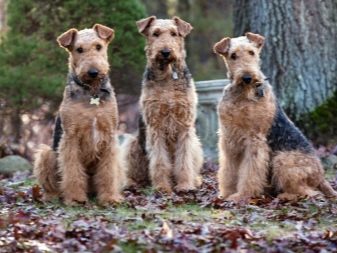
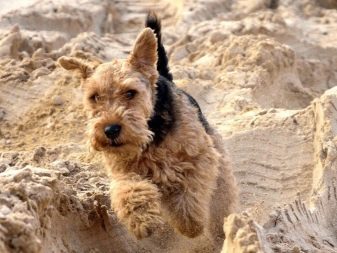
Origin history
It is curious that the Airedale and Yorkshire Terriers are countrymen originating from the same English county of Yorkshire, although they differ in appearance fundamentally. The breed got its name thanks to the Air River Valley, where it first appeared. The dog owes its appearance to the local workers who brought him out, crossing a red terrier (aka welsh terrier) with a coarse-haired Old English subspecies of a black and tan terrier and otterhound.
In 1864, a new dog first went to the exhibition, where it was sent to the Airedale Terrier Breeding Society, which existed at that time, although by that time the breed was not officially recognized and did not even have a standard name. At first, the new terrier was called simply wire-haired, then coastal, then bingley, and the modern name was fixed only in 1879. Seven years later, it was under this name that the dog was officially listed on the English club of dog lovers.

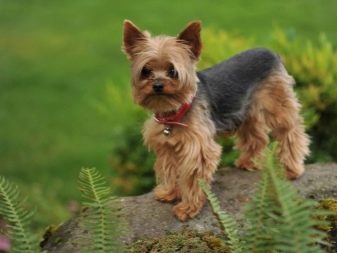
The place for breeding a new breed was not chosen by chance - throughout the year before last, the Eyre River Valley was famous as a venue for regular sports competitions, which consisted in catching large river rats with the help of hunting dogs. For these purposes, relatively small dogs were used that were able to fight the enemy directly on its territory, that is, in a hole.
Erdel turned out to be relatively large and did not crawl into holes, but, unlike most other terriers, he had an admixture of hounds, so he could chase the prey by smell, kill it independently and bring it to the owner. Such activities required considerable courage, strength and dexterity, so the dog quickly gained popularity among the “official” hunters and poachers, and soon began to be used also for the protection of farms or houses. To understand how quickly people rated the new breed, it should be clarified that the first dog went for export to the USA already in 1880 - even before the breed was officially recognized.
The first individual who arrived in the new country soon won the Terrier Show held in New York.
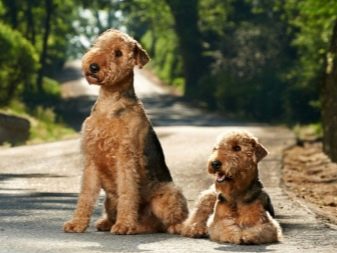

Already in 1904, the Russian embassy in Great Britain formally asked for help: they wanted to buy dogs that would help carry the wounded from the battlefield - Just started the Russo-Japanese war. The British helped: they put terriers, mainly Airedales, and since then the breed has taken root in Russia.
For several decades, they have been used as the main service dogs in various fields of activity. In 1906, airedale were appreciated in their own homeland - here they were taken to the police service, where they were originally accompanied by patrols involved in maintaining order in ship docks. It was these dogs that were chosen not only for their excellent flair, but also for their excellent quick wits and the utmost simplicity of caring for stiff hair.
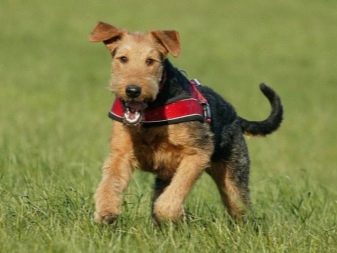
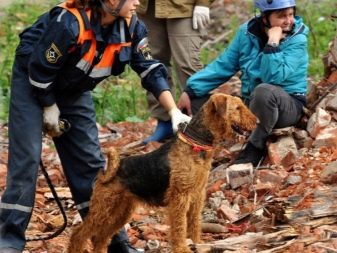
The First World War elevated the Airedale Terriers to the pinnacle of worldwide recognition - These first-class animals performed many important tasks, delivering mail, including over the front line, as well as searching for the wounded and pulling them out of the battlefield or bringing physicians to them. After the war, a wise and brave dog grew into legends, its popularity grew immensely, even several US presidents, including Theodore Roosevelt, Woodrow Wilson, Warren Harding and Calvin Coolidge, owned representatives of this particular breed.
Despite the impressive glory of these dogs, Airedale never knew mass distribution. For example, in the United States they reached the peak of their popularity in 1949, but even then they were included in only twenty of the most popular breeds, which is not bad for the then list of 110 breeds, but it does not allow talking about popular love.
To date, even such indicators for Airedale terriers are completely unrealistic - they do not always fall even in the top 50.
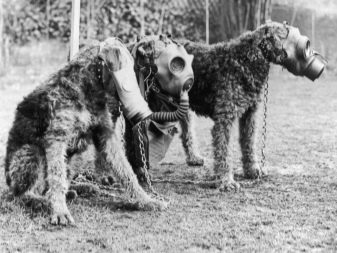

Description
Erdel’s language cannot be called small - among his fellow terriers he is rightly considered the largest. Compared to some other breeds, this dog may seem miniature - its height is 58–61 cm for males and up to 59 cm for females.
Although the growth characteristics practically do not differ depending on gender, things are completely different with the weight - the male weighs 30 kilograms, while for his girlfriend 20 kilograms are already the limit. Naturally, the difference in weight with the same height affects the size of the body - the girl looks like a mini-version of the boy.
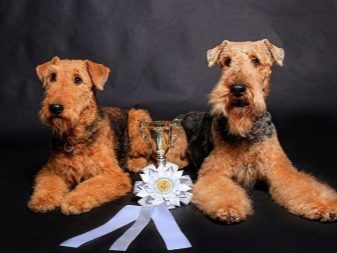
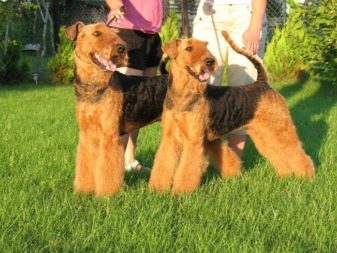
The standard assumes that the airedale's head is folded proportionally and has a narrow, elongated shape. There is no prominent forehead - it flows into the face smoothly, without a sharp transition. The muzzle itself is rectangular, a significant part of its width is occupied by an elongated nose, black at the end.The lips are closely pressed to the jaws, which are distinguished by high compression power and are dotted with large white teeth. It is extremely difficult to break out of the grip of such a dog.

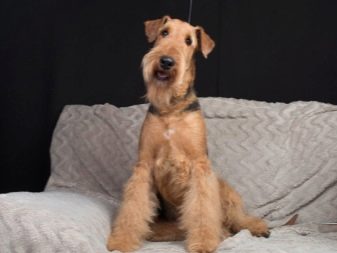
The dog has deep-set round eyes, the shade of which can vary, but is always dark - close to dark brown or black. According to the dog’s view, it’s already obvious he is smart and insightful. The ears are located close to each other, they are small and have the shape of a triangle, half hanging down, but still are not limp.
The neck is not very long or thick, but it is muscular and strong. Strong build is also characteristic of the dog’s body. - it is square, has a reliable skeleton, a powerful back and a developed chest. A highly placed tail is most often stopped - in the original conditions of the fight against the enemy, for which an airedale was created, it would only interfere with it. The body rests on elongated strong legs of a small size.

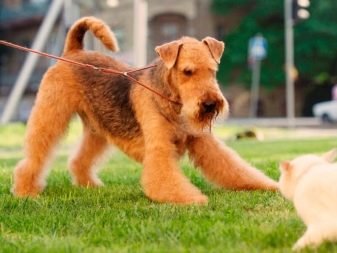
A distinctive feature of the dog is the increased stiffness of the coat - thick outer hairs are often compared with wire. The airedale is adapted to survive at low temperatures - a soft and dense undercoat hiding reliably retains heat is hidden under the “wire” sheath. This dog does not have a total length of hair - depending on the part of the body, it may be longer or shorter, but it curly and curly without fail.
A notable feature of the animal's appearance is the specific eyebrows, mustache and beard formed from hard hair.
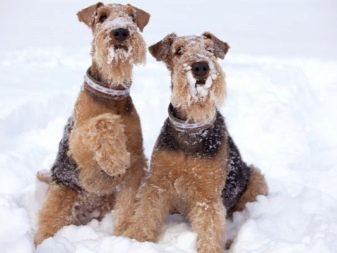
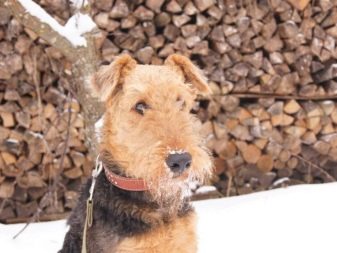
The standard allows for a certain variation in the color of the pet - it can be bright red or red-yellow, just yellow or brown, although the back always remains black. This color is usually called black. Wherein an important requirement is the uniformity of the "color" color - extraneous spots on the chest are still allowed, but they should be small and slightly affect the aesthetic perception of the individual.
Moreover, Airedale puppies from birth have a strictly black coat, only as they grow older it is replaced by a more familiar one.
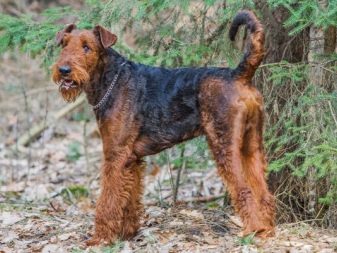
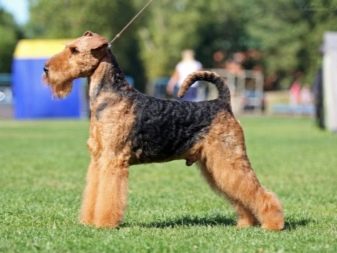
Character
Contrary to the fact that in its history the representatives of the breed sometimes had to solve very serious problems, an airedale is a cheerful dog, and among those who with pleasure will find another reason to have fun. A wise animal deliberately entertains itself and can figure out that the owner needs to cheer up, at the same time inventing how to do it.
Most often, such an energetic dog is a favorite of the whole family, including children, but it is noted that there are types of people with whom the character of an airedale is incompatible. These include too calm, harsh or tough people - in short, all those who do not support the pet’s desire to have fun.
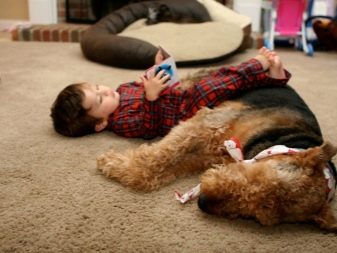

A smart dog becomes very attached to its owner, but does not create big problems for him - this is not a decorative doggie, which will defiantly "die" of grief every time the owner simply went to work.
A properly brought up dog will be glad to see the owner, but in his absence he will not go crazy. The dog is inclined to divide people into friends and strangers - for the first they are very friendly and count on signs of favor on their part. At the same time, the animal is not prone to servility - it is subordinate to man, but it is prone to build relations with the owner on conditions of relative parity.
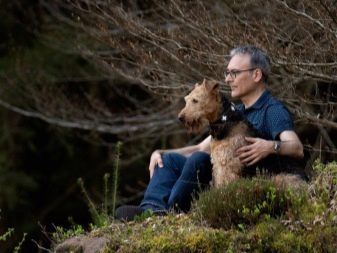
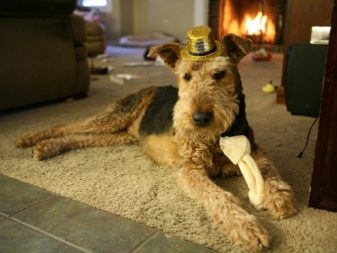
The hunting nature of the airedale can create certain problems in that it can coexist normally with other pets. In most cases, the dog is aggressive towards cats, rodents and birds., for him they are prey, which must not only be driven out of sight, but certainly caught up, killed and brought to the owner.
The only animals that the Airedale doesn’t fight with are the other dogs, including its breeds. Nevertheless, a certain upbringing from early childhood can solve the problem - there have been cases of friendship between a dog and those whom he usually considers to be his hunting goal.
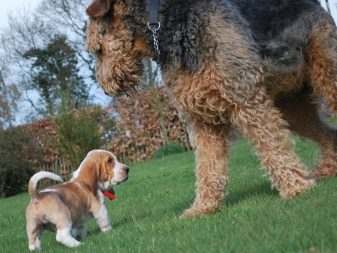
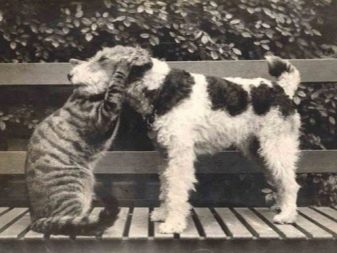
Aggressiveness (except for manifestations of the hunting instinct) is not characteristic of an airedale. He very rarely becomes the initiator of a fight, but the peacefulness disappears if the aggression is directed at the dog itself. Representatives of this breed are vindictive, they remember their offender well. If a neighbor’s dog offended the baby when he was a puppy, he will grow up and show signs of aggression towards the insolent, who now would not even risk provoking a matured enemy.
Such situations happen quite often, and since many owners forget about past hassles between dogs, they may have the wrong opinion that Erdel - a brawler who does not need a reason for scandal.
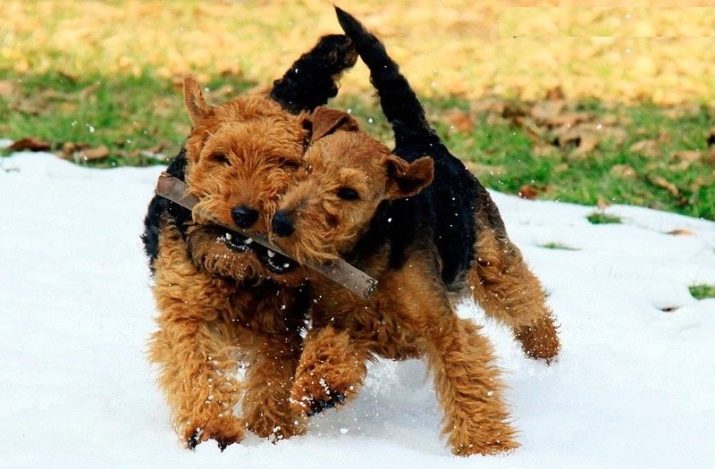
The mental abilities of a dog are largely assessed by the way it interacts with children. The airedale understands the difference between a child and an adult, he loves children and is ready to allow them a little more in view of the fact that they can cause a pet discomfort not only from evil, but from misunderstanding. At the same time, experienced owners advise not to leave the kids alone with the animal, but the reason lies not in aggression - just a large and quite active dog can accidentally push a little man, and he will fall.
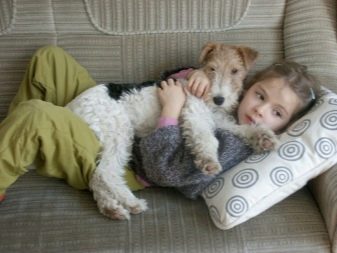
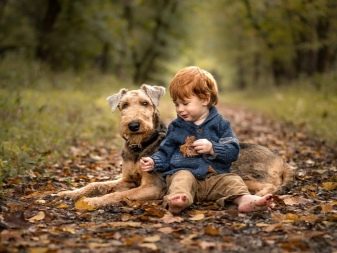
Life span
What the largest of the terriers cannot boast of is longevity indicators. It is noted that the average life expectancy of representatives of this breed is only 10-12 years, and even then, subject to proper care and the absence of diseases. Despite the fact that airedale are not considered particularly painful, they are still exposed to certain diseases that can shorten a dog's life span or turn its everyday life into suffering.
One of the most common problems for Airedale terriers is hip dysplasia, which is usually congenital. According to the puppy, the presence of such an ailment is not always noticeable from early childhood, but sooner or later it will lead to severe violations of the function of the hind limbs, the dog can become disabled.

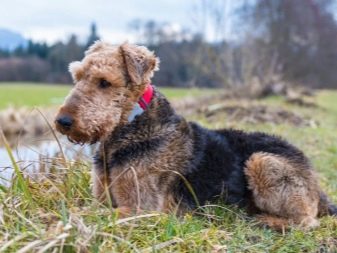
Of congenital diseases is also very dangerous von Willebrand disease - it is characterized by spontaneous bleeding that does not contribute to the formation of a full, physically healthy individual. Many diseases of Airedale are related to acquired ones; skin and eyes are most at risk. In contrast to the above-described congenital ailments, such problems can at least be effectively addressed.
Regular prevention and timely response to the first signs of a problem will help extend the life of the dog and protect it from any health problems.
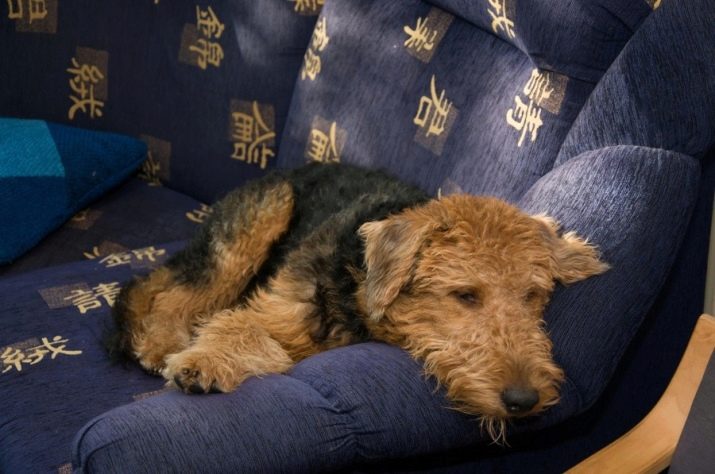
Comparison with the Welsh Terrier
The Airedale is often confused with the Welsh Terrier - two dogs are not only very similar to each other, but also are close relatives. Even those who clearly understand the difference between the two breeds are not always ready to answer straight away which of the two he would prefer. Consider the main differences between the two brothers.
- The key difference is that animals were bred for different purposes. The commonality of their appearance is due to the fact that both had a common ancestor - the Old English coarse-haired black and tan terrier, but the breeders pursued different goals in the process of breeding both. Welsh is a classic hunting terrier who is obliged to climb into the hole for prey and fight with it there. This is the reason for the fundamental requirement, according to which the height of the Welsh dog cannot exceed 40 cm.
Erdel, as we recall, is noticeably larger and does not climb holes, but he has certain hound skills and can pursue the beast on the surface.
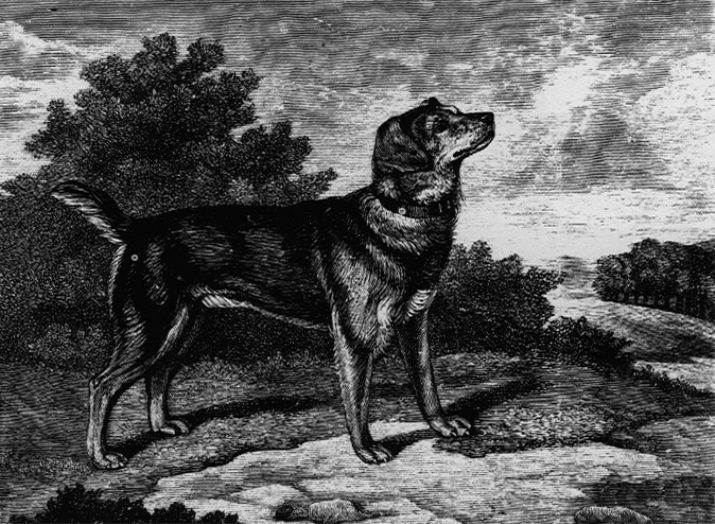
- Welsh terriers are sometimes mistakenly called the mini-version of the Airedale, but this, of course, is a mistake - the differences are not only in size, but also in proportion. For example, on a Welsh body, the head stands out noticeably stronger - it seems larger in relation to the body than the Airedale. The welsh ears, unlike their counterparts, are directed, as it were, a little forward. If the terriers from the Air River Valley are usually glued ears at a young age to adjust their shape, then for the "Welsh" this procedure is still rare.
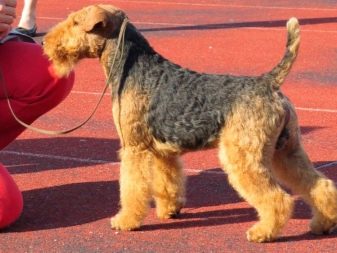

- In the description of both breeds it is indicated that the tail of the terrier should not be tightened by itself, but should not be pressed against the back. Owners of dogs of different breeds relate to deviations in the position of the tail in different ways, which is caused by the already mentioned features of the original use of animals. So, for the airedale, the position of the tail is not too fundamental - it is stopped and does not interfere in the fight, but it is not used for any practical purposes. Welsh relatives can still be used for hunting with penetration into burrows.
They need a standing tail so that it is convenient for the dog to be pulled out of the beast's den, so the tail pressed to the back is completely not welcome.
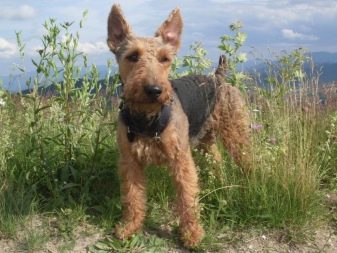
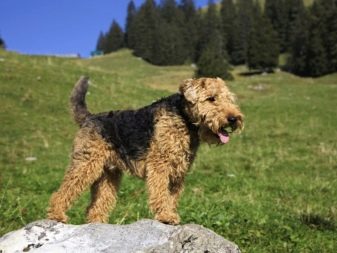
- The black color is characteristic of both breeds, but among the Welsh dogs, the opacity of the hind limbs is quite common. Since this is a completely typical feature, no one finds fault with it - it is considered a norm that does not contradict the standard. For an airedale, such a feature of appearance is not a direct inadmissibility of the exhibition, but be prepared that you will miss points.
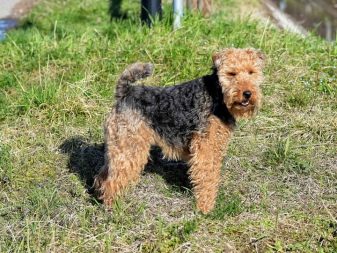
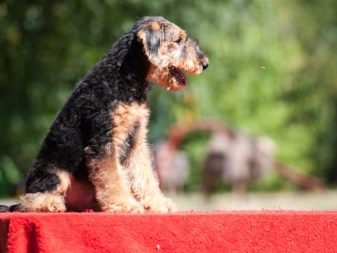
- Airedale are famous for their tough hair, which does not require any maintenance, but occasionally there are individuals with excessively soft hair, which is also called "sheep". For aesthetics, this could be a plus, but at dog shows they evaluate it not for the desire to stroke them, but for the ability to perform direct functions. Since the airedale is a hunting dog, soft fluff is completely useless for him - it will only get dirty and climb, so this is a clear minus for the individual. The Welsh problem is solved radically - they simply are not shreds.
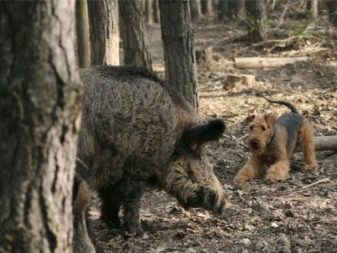
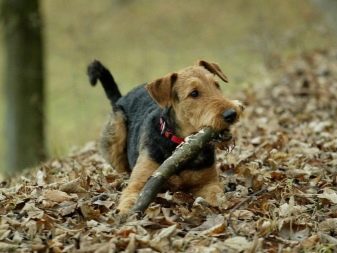
- Welsh terriers are often acquired by city dwellers, believing that in a cramped apartment, the "reduced copy of the airedale" will be just right. This is not entirely true - the compact dog is no less active than its larger brother, and in terms of cockiness it is even more impudent, since it was specially taken out for tough battles in tight conditions, where it simply does not work out to dodge the enemy’s attacks. Welsh is constantly looking for adventure, and he is also attracted to the owners' fur clothes, in which, what good, he can smell prey.
The difference in the behavior of the two dogs is especially noticeable on the hunt - the “Welshman” desperately tears into the thick of the fight, completely not thinking about the consequences for himself, while the Airedale terrier, faced with a superior enemy, tries to choose the tactics of small bites and attract the attention of the owner.
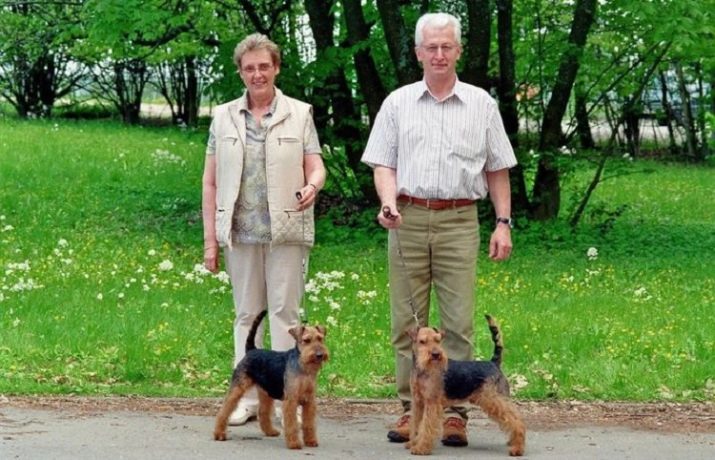
Features of care and maintenance
Despite its rather large dimensions, the airedale is well suited for home maintenance even in a city apartment, not to mention a country house with at least a small garden. A properly brought up dog does not create problems for its owners, behaves quietly and correctly..
An additional advantage of choosing in favor of representatives of this particular breed is also the fact that the wire-haired pet practically does not shed, which means that it creates fewer reasons for the development of allergies. However, saliva or animal dander can still replace dog hair as allergens.
Terriers from the Eyre Valley are not without a warm undercoat, but in the case of year-round keeping on the street in our conditions, care should be taken to insulate the dog’s housing - for this it is necessary to build a capital booth or construct a warmed aviary. The animal can be used as a reliable guard dog, especially if a particular individual was specially trained for this since childhood.
At the same time, we must not forget that the pet is very curious and not devoid of hunting instinct - if the animal is not limited, it may well be engaged in discovery activities and chase neighboring dogs, cats and other animals.
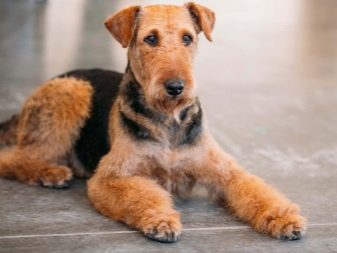
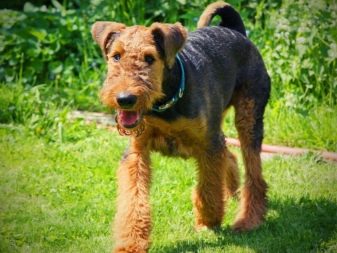
Airedale was created for a long pursuit of the goal, therefore it is unusual for him to sit still for a long time - the animal loves prolonged physical activity and needs regular walking. This is not a chain dog, a walk purely at the leash distance of the pet will not be counted - having seized the moment, the pet will simply run away to get the desired space. Experienced owners advise without fail to lower the airedale from the leash, being in a suitable place - where the dog does not get into a fight with any animals.
So that the pet is not overly carried away and does not run away to an unattainable distance, it should be kept at short distances with periodic calls. To make it interesting for the dog, during such short meetings you need to treat her with something.
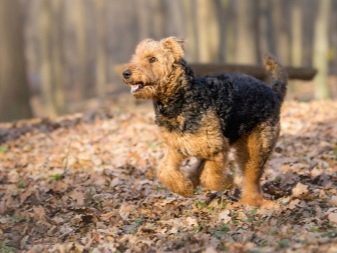
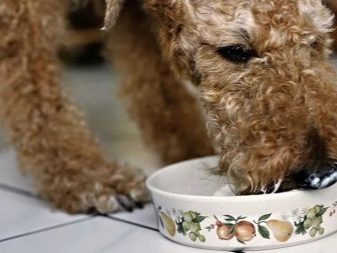
Statement that the hard wool of the Airedale terrier is completely maintenance-free - a kind of myth. Of course, care for this breed is a little easier than for decorative smooth-haired dogs, but combing should not be completely ignored, because otherwise it would be possible to develop one of the many potentially dangerous skin diseases. Since the airedale does not have a characteristic dog smell, it is not necessary to bathe it regularly.
Shedding for this variety of terriers is not characteristic, but the hairs in their cover are also capable of periodically dying. Trimming, that is, the removal of dead hairs, must be performed relatively rarely - once every 3-6 months.
Some owners master this process on their own and perform a similar duty without outside interference, but if you doubt your abilities, you can put the dog in the hands of specialists - they will do their job correctly, quickly and without unnecessary discomfort for the patient.

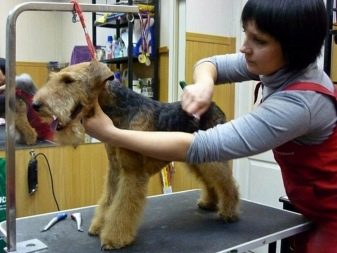
Please note that in the summer, the airedale’s coat can cause the dog some discomfort, so it will be wise and humane to cut it. This is usually done according to a scheme that allows you to save the characteristic features of the appearance of the animal. If all hair is cut relatively short, then the beard and mustache are carefully trimmed so that the thoroughbred dog remains itself.
On the contrary, it is undesirable to have a haircut before a cold and long Russian winter, since representatives of this species do not differ in their ability to withstand low temperatures. Moreover, for walking along the street, a blanket does not hinder the pet, allowing at least a little warming of the case.

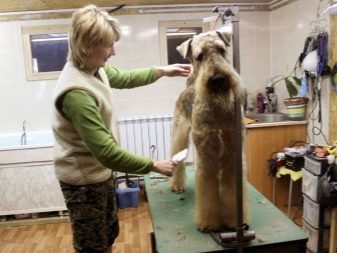
A thoroughbred English dog is not among the most susceptible to various acquired diseases, but it’s better once again to beware and engage in constant prevention of major diseases. An examination of the eyes, auricles and oral cavity is not done daily, as would be the case with decorative dogs, but once a week the owner is simply obliged to find time for this.
Cleaning your ears and teeth is also not necessary every day, but as necessary, you will have to perform such procedures - usually this happens at the moment when enough sulfur has accumulated in the ears, and a characteristic plaque has appeared on the teeth. At the same time, almost the only duty from which owners of an airedale are exempted is to cut their claws, although this condition is also met only if the pet does not lack regular exercise.
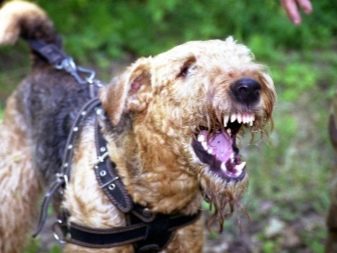

Feeding
The energetic behavior of the Airedale terrier involves constant replenishment of calories, while the menu should be balanced so that a fit and sporty dog does not turn into a barrel. You can feed your pet with both dry store feeds and natural products. In both cases, it makes sense previously consult with a veterinarian - he will tell you what food to choose and how to create a balanced program, including a sufficient amount of protein, fats and carbohydrates, as well as the necessary vitamins and minerals.
As befits a predator, the basis of the diet for airedale is meat and offal. It is not necessary to boil such a product, but it is advisable to cut it into pieces of such a size that the animal does not have to bite them. When choosing a meat variety, try to give preference to low-fat varieties, such as chicken, beef or rabbit meat.
Meat can and should be periodically replaced with fish, but not any - only marine should be chosen.
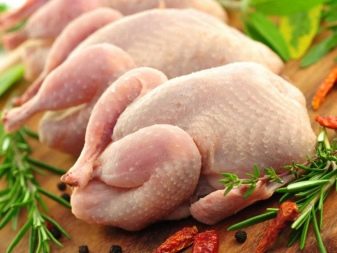

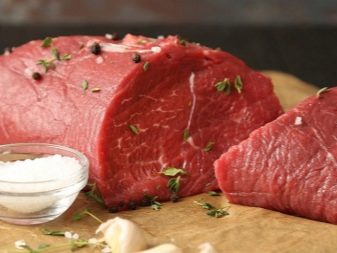

It is impossible to feed such a large dog with meat, and it makes no sense - the dog also needs a side dish as a source of carbohydrates. As such, it is necessary to use buckwheat, oatmeal or millet, it is better not to experiment with other cereals. Sour-milk products cannot be considered the basis of the dog's diet - they appear there relatively rarely and in small quantities, but there should be a place for them.
It is also not worth giving everything in a row - it is advisable to limit yourself to cottage cheese and kefir. Sometimes it makes sense to give a boiled egg - it contains a lot of useful things. Airedale terriers also need vegetables and fruits; some dogs are very fond of some varieties of plant foods.
From garden products should be given pumpkin, carrots and beets, from fruits, almost the only option available is apples.



A completely separate topic is products that, in principle, should not be given to airedale. In principle, this list is approximately the same for all dogs, but you should go over it again to avoid common mistakes and prevent possible digestive system health problems in your pet. That everything was in order, it is extremely undesirable to give him the following types of products:
- fatty meat - primarily pork, but also lamb, smoked meat and fish, as well as products from them;
- any sweet food, including pastries, chocolate, confectionery;
- spicy and spicy foods, including onions and garlic;
- citrus fruits in any form;
- pasta.



If in the case of an adult, the owner is free to choose whether to feed the pet with natural products or dry food, then in the case of puppies, emphasis should be placed on a self-made menu, while dry food is added gradually and only as the young grow up. note that young airedale eat little by little, but often - they are advised to feed them approximately 5-6 times a day.
Chewing activity is especially difficult for a small doggie, so the owner must make sure that the food acquires a consistency close to mashed potatoes, while it is best to focus on the room temperature of the products. Transfer to an adult diet occurs gradually - at about six months of age, an airedale can be fed only four times, and from eight months of age - only twice a day. Do not forget that the animal is growing, so reducing the number of meals should inevitably lead to higher dosages.
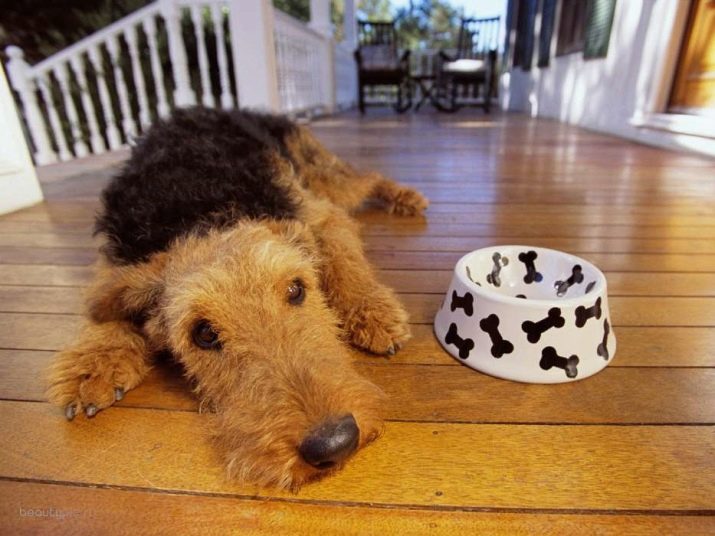
Parenting
The airedale is smart and quick-witted, it can be perfectly trained, but the logic that works for most dogs will not work here. Representatives of this breed are very masterful. If there is no desire to learn, it will not work to force the dog - even physical punishment does not scare her, and an attempt to bribe the pet with treats will be perceived as a spontaneous treat without any response.
The problem is A pet should be interested in practicing, if he was not accustomed to training from childhood, even an experienced trainer will not be able to remake it. Obedience and servility are generally not typical features of a curly four-legged, so that it will find a way to evade training.
To achieve the desired result, a person should start working with a puppy from an early age and push for excitement, which is inherent in any airedale from birth.
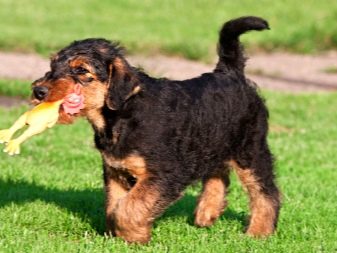
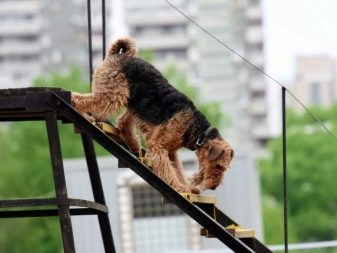
A common mistake of homegrown trainers is the repeated repetition of the same team. Representatives of this breed are very smart and grab new knowledge literally on the fly, but the repetition of a long-learned exercise, they quickly get bored, they stop responding to the team. Of course, a dog sometimes needs to be reminded of certain exercises, but this should happen less often than with other dogs.
Build a workout so that it does not look the same and hackneyed, but do not worry about the fatigue of the animal - it is extremely difficult to tire the Airedale terrier.
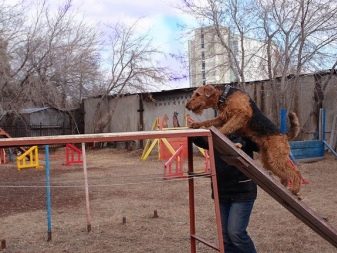
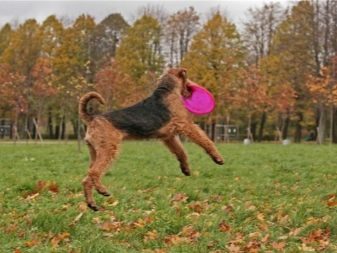
The dog instinctively loves to explore the surroundings and seek adventure, so it is important to teach him that the leash is a duty that cannot be ignored. In this case, you need to regularly give the dog the opportunity to let off steam - find the opportunity to go with the dog to a place where it can be released on all four sides. Knowing that the hour of the walk will come, the pet will behave more disciplined and will not run away from the leash.
At the same time, be prepared for the fact that this dog grows up at about two years of age - before that it often behaves irresponsibly.
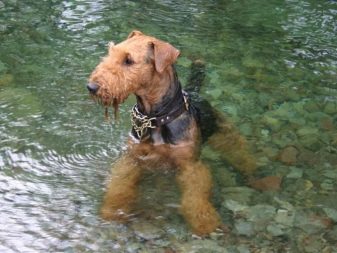
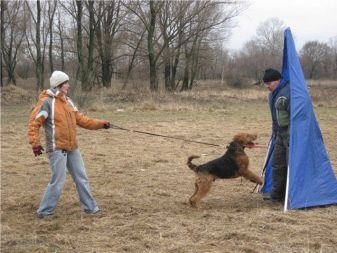
The Airedale is exactly the dog that you can and must accustom to the service, because such a pet is well suited for the needs of guarding the territory and protecting it from any extraneous attacks. Experts draw attention to the fact that you should not miss the moment while the young puppy is still amenable to education, therefore, if there are any misunderstandings in your communication with the pet, do not expect the problem to be solved by itself - contact a professional dog handler who still manages to educate the baby. When the age suitable for training passes, the dog will become as masterful as possible, so he will not be able to dictate his conditions to him.
From all of the above, it was possible to draw the erroneous conclusion that raising an Airedale is a difficult and ungrateful affair, therefore such a dog should not be brought up at all. True, it is only partly - you really have to tinker with the animal, but with the right approach and sufficient patience, you can raise a loyal furry friend from the baby, which will delight not only with its own cute appearance, but also with devotion, as well as the performance of guard or hunting functions.
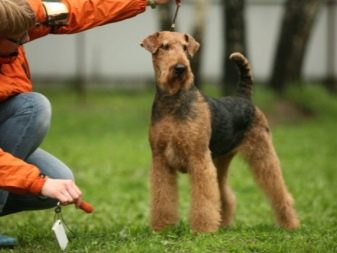

Popular nicknames
The Airedale is an active dog, and the owner’s task is to make the pet quickly respond to the appeal to him. For this reason experts advise calling the dog short and sonorous - so that you yourself do not get tired of repeatedly calling her during the day. Some owners prefer to invent a nickname for their dog on their own - this is original and allows you to reflect the tastes of a person on his dog.
In such cases, inspiration is usually found in literature or mythology, they call the beast in honor of real people, or even just invent a melodic nickname. This approach has the right to exist, but not every person has a fantasy that works quite well so that the name really matches a curly-haired dog.
In this situation, it will be most reasonable to check with what other dog breeders call similar dogs, fortunately, there are enough tips on this topic on the Internet.
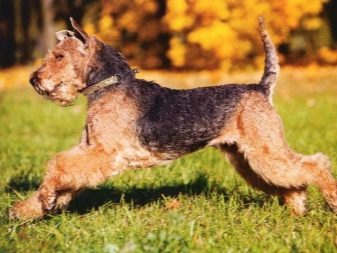

If you have a bitch, first of all pay attention to human female names of foreign origin. Options like Bessie, Greta, Gina, Lyme or Helga, fit the dog very organically - her enhanced curly look goes well with a reference to the celebrities with whom such names are associated.Often, inspiration is also sought in ancient legends, thanks to them nicknames like certain Vesta or Lyra.
Of purely domestic prevalence, it can only boast Haze, but this name pretty accurately describes the appearance of the pet.
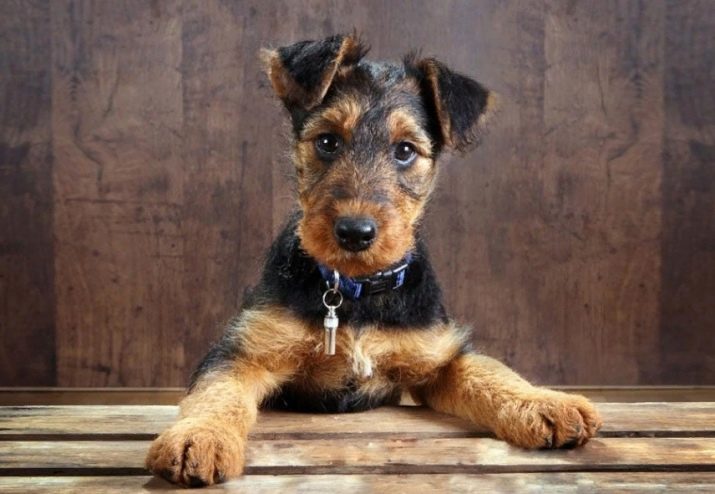
The list of nicknames for males is even wider - any foreign names that are at least slightly associated with aristocracy, like Glen, Ethan or Richard. However, not everyone is chasing the lofty - "common people" will come down Ike, Bob, Johnny, Kim, Mai, Pete, Teddy or Frank. For the unrestrained activity of the Airedale boys are often called Typhoons, and in the Black Sea it’s popular to call them also Scythians emphasizing an independent and nomadic character.
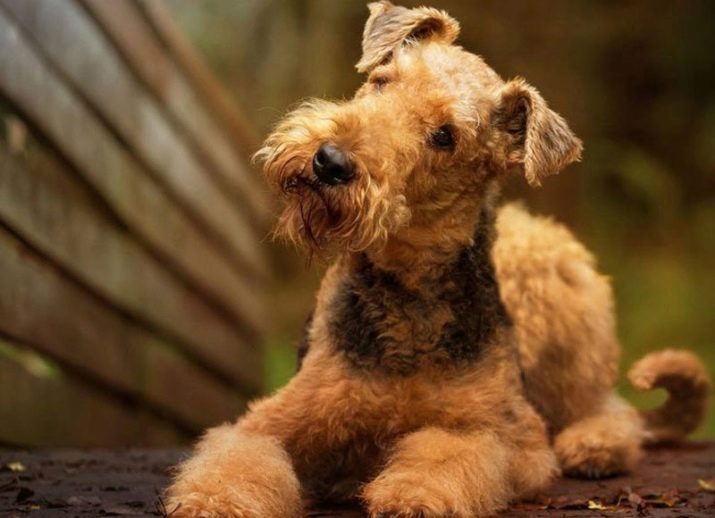
Owner reviews
Almost any owner of an airedale will confidently tell you that there is no better dog than his pet. This is not such a subjective opinion, because the mind and ingenuity for an airedale are innate and brightly developed features, and timely correct education allows you to turn the dog into an ideal that is useful in any situation. For an amateur dog lover, this is an excellent companion, for the owner of a personal plot - a reliable guard and defender, for a hunter he will become a faithful companion.
The outstanding personal attachment of a smart animal to its owner is exactly what people domesticated a dog for thousands of years ago. Of the obvious minuses attributed to representatives of this breed, one can distinguish only the waywardness and the desire to hunt for literally everything that moves. In fact, both problems are solved by timely education.
If the future owner in advance took an interest in the features of the breed before buying a puppy, he simply would not encounter a similar problem.
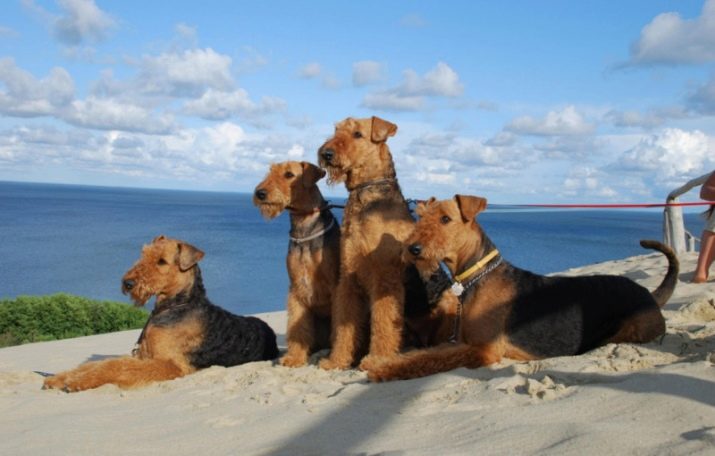
About the features of the breed, see the next video.








































